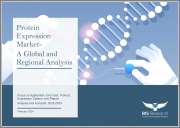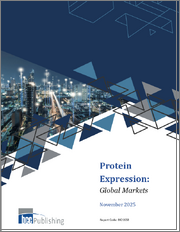
|
시장보고서
상품코드
1427001
단백질 발현 시장 - 세계 및 지역별 분석 : 용도별, 최종사용자별, 제품별, 발현 시스템별, 지역별 - 분석 및 예측(2023-2033년)Protein Expression Market - A Global and Regional Analysis: Focus on Application, End User, Product, Expression System, and Region - Analysis and Forecast, 2023-2033 |
||||||
세계 단백질 발현 시장 규모는 2023년 23억 9,300만 달러에 달했습니다.
이 시장은 2023년부터 2033년까지 11.27%의 CAGR로 확대되어 2033년에는 69억 6,360만 달러에 달할 것으로 예측됩니다. 단백질 발현은 살아있는 세포 및 생물체에서 단백질의 생성 및 생산을 포함합니다. 단백질의 합성, 변형 및 조절은 DNA에 암호화 된 유전 정보에 의해 유도됩니다. 단백질은 복잡하고 다양한 구조와 기능을 가지고 있으며, 생명을 유지하고 다양한 생물학적 활동을 촉진하는 데 필수적입니다.
| 주요 시장 통계 | |
|---|---|
| 예측 기간 | 2023-2033년 |
| 2023년 평가 | 23억 9,300만 달러 |
| 2033년 예측 | 69억 6,360만 달러 |
| CAGR | 11.27% |
연구자들은 실험, 생명공학, 의료 목적으로 단백질의 발현을 제어하기 위해 다양한 방법을 사용하고 있습니다. 살아있는 환경에서 단백질을 관찰하기 위해 종종 형광 단백질로 표시를 하여 분포를 연구할 수 있습니다.
비교적 쉽게 합성할 수 있는 DNA와 달리, 단백질 생산은 세포 유래의 복잡한 혼합물을 사용하거나 살아있는 세포 자체를 이용해야 합니다. 단백질 생산을 용이하게 하기 위해 포유류, 곤충, 박테리아, 식물, 효모, 무세포 환경을 기반으로 하는 등 다양한 발현 시스템이 사용되고 있습니다.
세계 단백질 발현 시장은 역동적이고 빠르게 발전하고 있는 분야로, 단백질 생물학적 제제에 대한 수요 증가와 단백질 발현 분야의 바이오의약품 연구개발 확대가 결합하여 두 자릿수 성장세를 보이고 있습니다. 다양한 연구개발에서 발현 시스템의 활용이 시장 성장에 더욱 기여하고 있습니다.
이 보고서는 세계 단백질 발현 시장을 조사하여 시장 개요와 함께 용도별, 최종사용자별, 제품별, 발현 시스템별, 지역별 동향, 시장 진입 기업 개요 등을 제공합니다.
목차
주요 요약
범위와 정의
제1장 시장
- 동향 : 현재 및 향후의 영향 평가
- 공급망 개요
- 연구개발 리뷰
- 규제 상황
- 주요 세계적 사건의 영향 분석 - COVID-19
- 시장 진출 장벽과 기회
- 시장 역학 개요
제2장 용도
- 용도 세분화
- 용도 개요
- 세계의 단백질 발현 시장(용도별)
- 세계의 단백질 발현 시장(최종사용자별)
제3장 제품
- 제품 세분화
- 제품 개요
- 세계의 단백질 발현 시장(제품별)
- 세계의 단백질 발현 시장(발현별)
제4장 지역
- 지역별 개요
- 성장 촉진요인과 억제요인
- 북미
- 유럽
- 아시아태평양
- 라틴아메리카
- 중동 및 아프리카
제5장 시장 - 경쟁 벤치마킹과 기업 개요
- 향후 전망
- 기업 평가
- 시장 생태계와 주요 기업
- Agilent Technologies, Inc.
- Bio-Rad Laboratories, Inc.
- Charles River Laboratories International, Inc.
- Danaher Corporation(Abcam plc.)
- GenCefe Co., Ltd.
- Genscript Biotech Corporation
- Jena Bioscience
- Lonza Bioscience
- Merck KGaA
- New England Biolabs
- Oxford Expression Technologies Ltd
- Promega Corporation
- QIAGEN N.V.
- Takara Bio Inc.
- Thermo Fisher Scientific, Inc.
제6장 조사 방법
ksm 24.02.27Introduction of Protein Expression
The global protein expression market was valued at $2,393.0 million in 2023 and is expected to reach $6,963.6 million by 2033, growing at a CAGR of 11.27% between 2023 and 2033. Protein expression involves the generation or production of proteins within living cells or organisms. The synthesis, modification, and regulation of proteins are guided by the genetic information encoded in DNA. These proteins possess intricate and varied structures and functions, which are vital for sustaining life and facilitating various biological activities.
Market Introduction
| KEY MARKET STATISTICS | |
|---|---|
| Forecast Period | 2023 - 2033 |
| 2023 Evaluation | $2,393.0 Million |
| 2033 Forecast | $6,963.6 Million |
| CAGR | 11.27% |
Various methodologies are employed by researchers to regulate protein expression for experimental, biotechnological, and medical purposes. To observe proteins in a living environment, they are often marked with fluorescent proteins, enabling the study of their distribution.
Unlike DNA, which can be synthesized with relative ease, protein production necessitates the use of complex mixtures derived from cells or the utilization of living cells themselves. To facilitate protein production, a variety of expression systems are employed, including those based on mammalian, insect, bacterial, plant, yeast, and cell-free environments.
Industrial Impact
The global protein expression market is a dynamic and rapidly evolving sector and is witnessing double-digit growth, driven by increased demand for protein biologics coupled with growing biopharmaceutical R&D in the field of protein expression. The utilization of expression systems in various research and development endeavors is further contributing to the market growth.
Market Segmentation:
Segmentation 1: by Application
- Biopharmaceutical Manufacturing
- Research and Development
- Industrial Usage
Biopharmaceutical Manufacturing Segment to Dominate the Protein Expression Market
Based on application, the global protein expression market was led by the biopharmaceutical manufacturing segment, with a 48.61% share in 2022. Protein expression plays a pivotal role in the manufacturing of biopharmaceuticals, involving the generation of therapeutic proteins using living cells, such as bacteria, yeast, or mammalian cells. The selection of a protein expression system hinges on the specific protein product and its intended application.
Segmentation 2: by End User
- Biopharmaceutical and Biotech Companies
- CRO and CDMO
- Academia
- Other End Users
Biopharmaceutical and Biotech Companies Segment to Witness the Highest Growth in the Market between 2023 and 2033
The primary end-use consumers of protein expression products and services are biopharmaceutical and biotechnology firms. They employ protein expression techniques to create and produce recombinant proteins for various purposes, including drug development, vaccine production, antibody synthesis, and hormone production. Prominent examples of such companies engaged in protein expression include Pfizer Inc., Merck KGaA, F. Hoffmann-La Roche Ltd, and Amgen Inc.
Segmentation 3: by Product
- Kits and Reagents
- Expression Vectors
- Competent Cells
- Plastic Consumables and Accessories
Based on products, the kits and reagents segment holds a larger share of the global protein expression market. Mature industry participants, including Merck KGaA, Agilent Technologies, Inc., and Thermo Fisher Scientific, dominate the market by providing an extensive array of kits and reagents to meet the demands of protein expression.
Segmentation 4: by Expression System
- Mammalian Cell Expression System
- Bacterial Cell Expression System
- Insect Cell Expression System
- Yeast Cell Expression System
- Others
Mammalian Cell Expression System to Witness the Highest Growth in the Market between 2023 and 2033
Based on various expression systems, mammalian cell-based expression systems hold a predominant position in the realm of biopharmaceutical production. These systems are employed for the transient or stable production of proteins, with the expression construct either temporarily introduced or integrated into the host genome. The preference for mammalian expression arises from its ability to create a highly physiologically relevant environment for studying protein function, thereby facilitating the utmost level of post-translational processing and functional activity of the produced protein.
Segmentation 5: by Region
- North America
- U.S.
- Canada
- Europe
- Germany
- U.K.
- France
- Italy
- Spain
- Rest-of-Europe
- Asia-Pacific
- Japan
- India
- China
- South Korea
- Australia
- Rest-of-Asia-Pacific
- Latin America
- Brazil
- Mexico
- Rest-of-Latin America
- Middle East and Africa
- South Africa
- Israel
- Saudi Arabia
- Rest-of-Middle East and Africa
Recent Developments in the Protein Expression Market
- In January 2024, Evosep, a leader in sample preparation for mass spectrometry-based proteomics, partnered with Thermo Fisher Scientific Inc., a global scientific leader, to advance clinical proteomics research. This collaboration would combine Evosep's sample separation technology with Thermo Fisher Scientific Inc.'s mass spectrometry instruments, enhancing proteomics research capabilities.
- In July 2023, Lonza Bioscience introduced the TheraPRO CHO Media System, a novel cell culture platform designed to streamline processes and enhance productivity and protein quality, particularly when used in conjunction with GS-CHO cell lines. This release would support pharmaceutical and biotechnology companies engaged in the manufacturing of therapeutic proteins, with the goal of improving product quality and expediting time-to-market.
- In October 2023, Thermo Fisher Scientific Inc. announced a $3.1 billion acquisition deal with Sweden's Olink Holding to bolster its presence in the proteomics market. This agreement was jointly disclosed by the two companies.
- In December 2023, Medical equipment supplier Danaher Corporation (Abcam plc.) announced the successful completion of its $5.7 billion acquisition of Danaher Corporation (Abcam plc.) despite initial resistance from the founder of the protein consumables manufacturer.
Demand - Drivers, Challenges, and Opportunities
Market Demand Drivers:
Increasing Demand for Protein Biologics Creating the Need for Protein Expression: Biologics represent a category of pharmaceutical drugs derived from biological sources. They can be produced from, extracted from, or semi-synthesized from biological materials. These drugs consist of proteins, sugars, nucleic acids, or intricate combinations of these components and can even include living cells or tissues. Biologics find application in both human and animal healthcare and are employed to treat a range of medical conditions when no alternative treatments are accessible.
Market Challenges:
Long and Complicated Regulatory Timelines and Approvals of Recombinant Proteins and Biologics: Recombinant proteins, generated through genetic engineering methods, belong to a category of proteins employed in the development of biopharmaceuticals, which are pharmaceutical drugs derived from biological sources. The production of these recombinant proteins falls under the oversight of regulatory authorities worldwide.
Market Opportunities:
Advancements in Microfluidics Requiring the Use of Protein Expression: Microfluidics is a scientific discipline that focuses on studying, manipulating, and controlling fluids at the microscale level. It has brought about a significant transformation in our approach to studying and examining biological systems. One particularly exciting application of microfluidics is within the realm of protein expression. Innovative microfluidic devices have been created to simplify the process of loading and cultivating cells, allowing for efficient parallel transfection, culturing, and analysis of mammalian cells.
How Can This Report Add Value to an Organization?
Product/Innovation Strategy: The global protein expression market has been segmented on the basis of various categories, such as application, end user, offering, expression system, and region. Segments such as by offering have been further sub-segmented to ensure the comprehensiveness and thoroughness of the report.
Growth/Marketing Strategy: Product launches and synergistic activities together accounted for the maximum number of key developments, at nearly 67% of the total developments in the protein expression market between January 2021 and December 2023.
Competitive Strategy: The global protein expression market is a highly fragmented one, with many smaller and private companies constantly entering it. Key players in the protein expression market analyzed and profiled in the study involve established players that offer various kinds of products and services.
Methodology
Key Considerations and Assumptions in Market Engineering and Validation
- The base year considered for the calculation of the market size is 2022. A historical year analysis has been done for the period FY2019-FY2021. The market size has been estimated for FY2022 and projected for the period FY2023-FY2033.
- The scope of this report has been carefully derived based on interactions with experts in different companies across the world. This report provides a market study of protein expression.
- The market contribution of protein expression anticipated to be launched in the future has been calculated based on the historical analysis of the solutions.
- Revenues of the companies have been referenced from their annual reports for FY2022 and FY2023. For private companies, revenues have been estimated based on factors such as inputs obtained from primary research, funding history, market collaborations, and operational history.
- The market has been mapped based on the available protein expression solutions. All the key companies with significant offerings in this field have been considered and profiled in this report.
Primary Research:
The primary sources involve industry experts in protein expression, including the market players offering products and services. Resources such as CEOs, vice presidents, marketing directors, and technology and innovation directors have been interviewed to obtain and verify both qualitative and quantitative aspects of this research study.
The key data points taken from the primary sources include:
- validation and triangulation of all the numbers and graphs
- validation of the report's segmentation and key qualitative findings
- understanding the competitive landscape and business model
- current and proposed production values of a product by market players
- validation of the numbers of the different segments of the market in focus
- percentage split of individual markets for regional analysis
Secondary Research
Open Sources
- Certified publications, articles from recognized authors, white papers, directories, and major databases, among others
- Annual reports, SEC filings, and investor presentations of the leading market players
- Company websites and detailed study of their product portfolio
- Gold standard magazines, journals, white papers, press releases, and news articles
- Paid databases
The key data points taken from the secondary sources include:
- segmentations and percentage shares
- data for market value
- key industry trends of the top players of the market
- qualitative insights into various aspects of the market, key trends, and emerging areas of innovation
- quantitative data for mathematical and statistical calculations
Key Market Players and Competition Synopsis
The companies that are profiled have been selected based on inputs gathered from primary experts and analyzing company coverage, product portfolio, and market penetration.
Some prominent names established in this market are:
- Agilent Technologies, Inc.
- Bio-Rad Laboratories, Inc.
- Charles River Laboratories International, Inc.
- Danaher Corporation (Abcam plc.)
- GenCefe Co., Ltd.
- Genscript Biotech Corporation
- Jena Bioscience
- Lonza Bioscience
- Merck KGaA
- New England Biolabs
- Oxford Expression Technologies Ltd
- Promega Corporation
- QIAGEN N.V.
- Takara Bio Inc.
- Thermo Fisher Scientific, Inc.
Table of Contents
Executive Summary
Scope and Definition
1 Markets
- 1.1 Trends: Current and Future Impact Assessment
- 1.1.1 Protein Expression Market Trend Analysis
- 1.1.2 Continuous Innovations in Fields such as Automation of Protein Expression Processes
- 1.1.3 Advancements in Protein Engineering and Design
- 1.2 Supply Chain Overview
- 1.2.1 Value Chain Analysis
- 1.2.2 Market Map
- 1.3 Research and Development Review
- 1.3.1 Patent Filing Trend (by Country, Year)
- 1.4 Regulatory Landscape
- 1.5 Impact Analysis for Key Global Events - COVID-19
- 1.6 Market Entry Barriers and Opportunities
- 1.6.1 Pain Points for Manufacturers
- 1.6.2 Opportunities for Manufacturers
- 1.7 Market Dynamics Overview
- 1.7.1 Market Drivers
- 1.7.1.1 Increasing Demand for Protein Biologics Creating the Need for Protein Expression
- 1.7.1.2 Increasing Biopharmaceutical R&D Influencing the Use of Protein Expression
- 1.7.1.3 Increasing Protein Synthesis Funding
- 1.7.2 Market Restraints
- 1.7.2.1 Long and Complicated Regulatory Timelines and Approvals of Recombinant Proteins and Biologics
- 1.7.2.2 Intricate and Fluctuating Nature of Protein Expression Necessitating a Demand for Highly Trained Personnel
- 1.7.3 Market Opportunities
- 1.7.3.1 Advancements in Microfluidics Requiring the Use of Protein Expression
- 1.7.3.2 Rising Awareness of Proteomics in Emerging Countries
- 1.7.1 Market Drivers
2 Application
- 2.1 Application Segmentation
- 2.2 Application Summary
- 2.3 Global Protein Expression Market (by Application)
- 2.3.1 Biopharmaceutical Manufacturing
- 2.3.2 Research and Development
- 2.3.3 Industrial Usage
- 2.4 Global Protein Expression Market (by End User)
- 2.4.1 Biopharmaceutical and Biotech Companies
- 2.4.2 CRO and CDMO
- 2.4.3 Academia
- 2.4.4 Others
3 Product
- 3.1 Product Segmentation
- 3.2 Product Summary
- 3.2.1 Product Summary
- 3.2.2 Expression System Summary
- 3.3 Global Protein Expression Market (by Product)
- 3.3.1 Kits and Reagents
- 3.3.2 Expression Vectors
- 3.3.3 Competent Cells
- 3.3.4 Plastic Consumables and Accessories
- 3.4 Global Protein Expression Market (by Expression System)
- 3.4.1 Mammalian Cell Expression System
- 3.4.2 Yeast Cell Expression System
- 3.4.3 Bacterial Cell Expression System
- 3.4.4 Insect Cell Expression System
- 3.4.5 Other Expression System
4 Region
- 4.1 Regional Summary
- 4.2 Drivers and Restraints
- 4.3 North America
- 4.3.1 Regional Overview
- 4.3.2 Driving Factors for Market Growth
- 4.3.3 Factors Challenging the Market
- 4.3.4 Application
- 4.3.5 Products
- 4.3.6 U.S.
- 4.3.6.1 Application
- 4.3.6.2 Product
- 4.3.7 Canada
- 4.3.7.1 Application
- 4.3.7.2 Product
- 4.4 Europe
- 4.4.1 Regional Overview
- 4.4.2 Driving Factors for Market Growth
- 4.4.3 Factors Challenging the Market
- 4.4.4 Application
- 4.4.5 Product
- 4.4.6 France
- 4.4.6.1 Application
- 4.4.6.2 Product
- 4.4.7 Germany
- 4.4.7.1 Application
- 4.4.7.2 Product
- 4.4.8 U.K.
- 4.4.8.1 Application
- 4.4.8.2 Product
- 4.4.9 Spain
- 4.4.9.1 Application
- 4.4.9.2 Product
- 4.4.10 Italy
- 4.4.10.1 Application
- 4.4.10.2 Product
- 4.4.11 Rest-of-Europe
- 4.4.11.1 Application
- 4.4.11.2 Product
- 4.5 Asia-Pacific
- 4.5.1 Regional Overview
- 4.5.2 Driving Factors for Market Growth
- 4.5.3 Factors Challenging the Market
- 4.5.4 Application
- 4.5.5 Product
- 4.5.6 China
- 4.5.6.1 Application
- 4.5.6.2 Product
- 4.5.7 India
- 4.5.7.1 Application
- 4.5.7.2 Product
- 4.5.8 Australia
- 4.5.8.1 Application
- 4.5.8.2 Product
- 4.5.9 Japan
- 4.5.9.1 Application
- 4.5.9.2 Product
- 4.5.10 South Korea
- 4.5.10.1 Application
- 4.5.10.2 Product
- 4.5.11 Rest-of-Asia-Pacific
- 4.5.11.1 Application
- 4.5.11.2 Product
- 4.6 Latin America
- 4.6.1 Regional Overview
- 4.6.2 Driving Factors for Market Growth
- 4.6.3 Factors Challenging the Market
- 4.6.4 Application
- 4.6.5 Product
- 4.6.6 Brazil
- 4.6.6.1 Application
- 4.6.6.2 Product
- 4.6.7 Mexico
- 4.6.7.1 Application
- 4.6.7.2 Product
- 4.6.8 Rest-of-Latin America
- 4.6.8.1 Application
- 4.6.8.2 Product
- 4.7 Middle East and Africa
- 4.7.1 Regional Overview
- 4.7.2 Driving Factors for Market Growth
- 4.7.3 Factors Challenging the Market
- 4.7.4 Application
- 4.7.5 Product
- 4.7.6 Israel
- 4.7.6.1 Application
- 4.7.6.2 Product
- 4.7.7 Saudi Arabia
- 4.7.7.1 Application
- 4.7.7.2 Product
- 4.7.8 South Africa
- 4.7.8.1 Application
- 4.7.8.2 Product
- 4.7.9 Rest-of-Middle East and Africa
- 4.7.9.1 Application
- 4.7.9.2 Product
5 Markets - Competitive Benchmarking & Company Profiles
- 5.1 Next Frontiers…..
- 5.2 Company Assessment
- 5.3 Market Ecosystem and Key Players
- 5.3.1 Agilent Technologies, Inc.
- 5.3.1.1 Overview
- 5.3.1.2 Top Products/Product Portfolio
- 5.3.1.3 Top Competitors
- 5.3.1.4 Key Personnel
- 5.3.1.5 Analyst View
- 5.3.2 Bio-Rad Laboratories, Inc.
- 5.3.2.1 Overview
- 5.3.2.2 Top Products/Product Portfolio
- 5.3.2.3 Top Competitors
- 5.3.2.4 Key Personnel
- 5.3.2.5 Analyst View
- 5.3.3 Charles River Laboratories International, Inc.
- 5.3.3.1 Overview
- 5.3.3.2 Top Services/Service Portfolio
- 5.3.3.3 Top Competitors
- 5.3.3.4 Key Personnel
- 5.3.3.5 Analyst View
- 5.3.4 Danaher Corporation (Abcam plc.)
- 5.3.4.1 Overview
- 5.3.4.2 Top Products/Product Portfolio
- 5.3.4.3 Top Competitors
- 5.3.4.4 Key Personnel
- 5.3.4.5 Analyst View
- 5.3.5 GenCefe Co., Ltd.
- 5.3.5.1 Overview
- 5.3.5.2 Top Services/Service Portfolio
- 5.3.5.3 Top Competitors
- 5.3.5.4 Key Personnel
- 5.3.5.5 Analyst View
- 5.3.6 Genscript Biotech Corporation
- 5.3.6.1 Overview
- 5.3.6.2 Top Services/Service Portfolio
- 5.3.6.3 Top Competitors
- 5.3.6.4 Key Personnel
- 5.3.6.5 Analyst View
- 5.3.7 Jena Bioscience
- 5.3.7.1 Overview
- 5.3.7.2 Top Products/Product Portfolio
- 5.3.7.3 Top Competitors
- 5.3.7.4 Key Personnel
- 5.3.7.5 Analyst View
- 5.3.8 Lonza Bioscience
- 5.3.8.1 Overview
- 5.3.8.2 Top Services/Service Portfolio
- 5.3.8.3 Top Competitors
- 5.3.8.4 Key Personnel
- 5.3.8.5 Analyst View
- 5.3.9 Merck KGaA
- 5.3.9.1 Overview
- 5.3.9.2 Top Products/Product/Service Portfolio
- 5.3.9.3 Top Competitors
- 5.3.9.4 Key Personnel
- 5.3.9.5 Analyst View
- 5.3.10 New England Biolabs
- 5.3.10.1 Overview
- 5.3.10.2 Top Products/Product Portfolio
- 5.3.10.3 Top Competitors
- 5.3.10.4 Key Personnel
- 5.3.10.5 Analyst View
- 5.3.11 Oxford Expression Technologies Ltd
- 5.3.11.1 Overview
- 5.3.11.2 Top Products/Product Portfolio
- 5.3.11.3 Top Competitors
- 5.3.11.4 Key Personnel
- 5.3.11.5 Analyst View
- 5.3.12 Promega Corporation
- 5.3.12.1 Overview
- 5.3.12.2 Top Products/Product Portfolio
- 5.3.12.3 Top Competitors
- 5.3.12.4 Target Customers
- 5.3.12.5 Key Personnel
- 5.3.12.6 Analyst View
- 5.3.13 QIAGEN N.V.
- 5.3.13.1 Overview
- 5.3.13.2 Top Products/Product Portfolio
- 5.3.13.3 Top Competitors
- 5.3.13.4 Key Personnel
- 5.3.13.5 Analyst View
- 5.3.14 Takara Bio Inc.
- 5.3.14.1 Overview
- 5.3.14.2 Top Products/Product Portfolio
- 5.3.14.3 Top Competitors
- 5.3.14.4 Key Personnel
- 5.3.14.5 Analyst View
- 5.3.15 Thermo Fisher Scientific, Inc.
- 5.3.15.1 Overview
- 5.3.15.2 Top Products/Product Portfolio
- 5.3.15.3 Top Competitors
- 5.3.15.4 Key Personnel
- 5.3.15.5 Analyst View
- 5.3.1 Agilent Technologies, Inc.
6 Research Methodology
- 6.1 Data Sources
- 6.1.1 Primary Data Sources
- 6.1.2 Secondary Data Sources
- 6.1.3 Data Triangulation
- 6.2 Market Estimation and Forecast



















